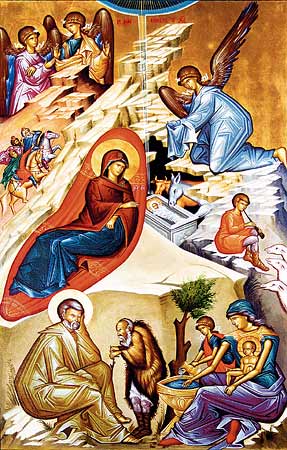Soon we celebrate the birth of our Lord. We can understand better the structure of the feast, in the Byzantine Church, by looking at the Gospels which are read:
1) On the Sunday before Christmas, we read the genealogy of Jesus. Moreover, on this Sunday, we do read the birth of Christ according to St. Matthew. This is the beginning of the feast.
2) On Christmas eve, at Vespers and the Liturgy of St. Basil, we read the gospel of Jesus’ birth according to St. Luke. The greatest feasts (Christmas, Theophany and Pascha) all have this two-liturgy structure in the Byzantine Liturgy. The vigil Liturgy is a true Christmas Liturgy, and the fast is broken after Vespers. However, the abstinence continues until midnight, but Holy Suppers are quite festive for all that and very full.
3) The Gospel of the birth of Jesus is again read at Orthros (Matins, the morning service) of December 25.
4) On Christmas Day, at the Liturgy of St. John Chrysostom, the first event after Jesus’ birth, the gospel of the Magi is read. In the Roman tradition, this is the gospel of Epiphany on January 6. Of course, we know that the Magi visited long after Jesus’ birth, Herod killed the infants two years old and younger.
5) On the day after Christmas, and on the Sunday after Christmas, the Gospel of the massacre of the Holy Infants is read. I think this reminds us that Christmas is a very serious feast that challenges us to choose our Lord as the true king of God’s Kingdom. We often make it into a sentimental, “feel-good” feast in which we are nice to each other, but it is truly a theological feast, of God becoming incarnate and of all that this means for our human lives. He became poor for our sakes that in his poverty we might become rich (1 Corinthians 8:9).
Archpriest David Petras
